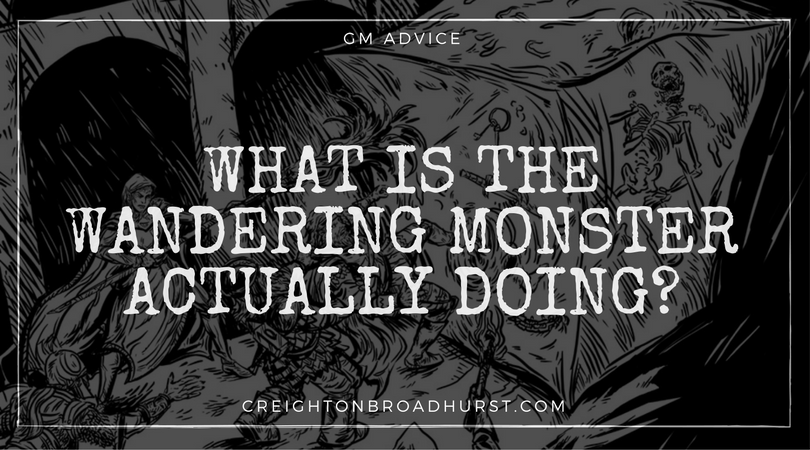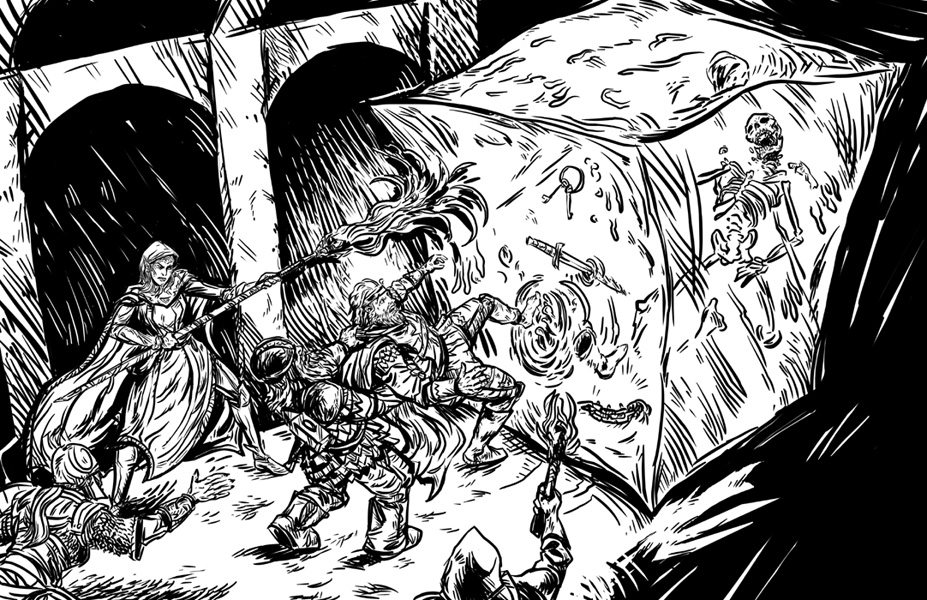Wandering monsters are an essential component of any dungeon larger than a couple of rooms. Their presence adds verisimilitude, depth and an interesting element of randomness and unpredictability to proceedings.
However, to avoid boring and bland wandering monster encounters that make no real sense you need to think about a couple of things. Principally, beyond determining what kind of monsters the party encounters, you should consider:
Beyond wandering, what are the wandering monsters actually doing?
That’s a pretty important question. The answer has a huge influence on the encounter set-up. For example—obviously—a gelatinous cube is unlikely to be setting up camp for the night. Other wanderers, however, have more complex motivations and reasons for their actions. In a troglodyte tribal den, for example, wandering troglodytes might be:
- fetching water
- carrying away rubbish
- watching for intruders
- doing anything else troglodytes do in their lairs
Whatever the troglodytes are doing, they are unlikely to be hanging around doing nothing (except those darn lazy teenage troglodytes, that is).
There are three basic types of wandering monster. Each type gets up to different things in the dungeon. Use the lists below, to determine what a randomly encountered monster is doing. Remember, some results may make no sense when paired with the wanderers in question; modify the results as appropriate.
Organised Dungeon Denizens
These wanderers belong to the group controlling the dungeon (or this part of the dungeon). When encountered, the dungeon denizens are:
- Patrolling their lair
- Shirking their duties (drinking, gambling, sleeping etc.)
- Carrying water
- Disposing of rubbish
- Escorting a prisoner
- Watching for intruders
- Chasing an escaped slave or prisoner
- Repairing something such as a door, piece of furniture etc.
- Moving foodstuffs or other heavy items about the lair
- Loitering
- Decorating something with graffiti
- Arguing
- Baiting a prisoner or small animal
- Eating
- Paling to watch for intruders (they could be asleep, drunk etc.)
- Preparing to go on a scouting mission
- Brawling with each other
- Plotting against their chieftain or leader
- Nefariously sneaking about
- Making a lot of noise—perhaps shouting or singing
As well as the dungeon’s denizens, the party might instead encounter their slaves or an escaped prisoner. Such encounters will likely result in role-playing rather than combat and could even serve as a useful source of intelligence.
Other Explorers
The PCs encounter another adventuring group or members of a group working against the dungeon’s denizens. The other party could be friendly (or not). When encountered, the explorers or interlopers are:
- Sneaking towards their enemies
- Returning from a raid with a prisoner
- Resting
- Setting up camp
- Breaking camp
- Setting a trap
- Waiting to spring an ambush
- Wandering about lost
- Spying on their enemies
- Searching for something hidden (a secret door, trap or treasure niche)
Scavengers
Some monsters are nothing more than mindless or near-mindless scavengers, driven by their base, atavistic influences. Rats, giant spiders and gelatinous cubes all fall into this category. The other dungeon denizens may tolerate, fear or hunt these scavengers. Scavengers rarely deliberately carry treasure with them. When encountered, the scavengers are:
- Sleeping
- Resting
- Eating
- Hiding
- Waiting to pounce
- Creating a new nest or lair
- Dragging or carrying something (probably prey) back to their lair
- Chasing prey
The Final Word
The above lists are by no means all-encompassing. However, they should serve as a useful starting point to spark your imagination. When designing a random encounter on the fly, remember randomly encountered monsters:
- are doing something when encountered; they are rarely just hanging around waiting to be killed
- are not always aware of the PCs before the PCs become aware of them
- don’t always want to fight
- might want to ally themselves with the PCs
Practically, from a GM’s point of view, wandering monsters can be:
- a great way of slowing down or diverting the party
- a good way of “topping up” the party’s XP
- a way to provide the party with vital resources—such as a scroll or other magic item—they currently lack
A version of this article appears in the Gloamhold Campaign Guide, available from Raging Swan Press.
Thank You
Thank you to Chris Nielsen for making me ponder this subject.
What Do You Think?
Do you love or hate wandering monsters? Let me know, in the comments below.


Brilliant article! I always try to conceptualize what, how, and why monsters live in a certain area, especially those in a dungeon settings, and has created even more interesting dungeon set-ups. I’m going to apply your lists to my game. Thanks!
Thanks very much, Doug! Glad you found it useful.
You missed mating. Or perhaps you covered it with #20 Making a lot of noise
the comments you make in “the final word” are particularly on target. Also, the wandering monster, while it may not necessarily ally itself with the party, might serve as a sympathetic figure. They might not want to fight you, and really just don’t want to die today. as such, they might even be willing (and not just for the sake of doing something to spare their life!) to help out the party in some way … food / water, a badly needed piece of equipment, even a piece of information. Or, if the party is trying to get away, the wandering monster might even try to delay others so that the party can escape (after all, they might be holding a grudge against another monster in the area, and what better way to get back at them than to thwart their blood-thirsty efforts to get the party of adventurers?)
Great article. I go so far as to have lairs for most wandering monsters in my dungeons (with the exception of undead and creatures small enough to fit through cracks the PCs can’t, though I make sure to know where those cracks are). Sometimes it’s a mated pair with one wandering and the other in the lair. Not sure if I’m going too deep on the wandering monster thing here, but it seems like it should be somewhere when it’s not wandering.
That’s a great point. Most wandering monsters would absolutely have a home or lair. Having the PCs potentially discover that later is a very cool bit of flavour.
Good suggestions – thanks! Serendipitously, Tabletop Terrors is hosting this month’s RPG Blog Carnival with the theme of ‘Encounters’
http://tabletopterrors.com/rpg-blog-carnival-february-2017-rethink-encounters/
What a handy coincidence!
Being as my name is Chris Nielsen, I was completely caught by surprise and lost initiative when I read the last bit of the article. Great article thanks!
I was the leader of an ad hoc party in a dungeon that one of my players was running. My character had a high CHA, so I negotiated with about half the monsters in there to “join us for the day, and I’ll get you out of this dungeon”.
Trying to get their 10,000 daily steps in?
The classic RuneQuest adventure ”Snakepipe Hollow” has tables like this for wandering monsters, as well as tables for the rooms they normally occupy. If you encounter a creature when its wandering, you can’t legitemately encounter him in his lair if you’ve previously killed him, or he vouldn’t have returned to his lair in time. All the monsters have a backstory for why they are where they are. Wonderful adventure.